
Keene is a town in central Essex County, New York, United States. It includes the hamlets of Keene, Keene Valley, and St. Huberts, with a total population of 1,105 as of the 2010 census.

Port Henry is a hamlet in Essex County, New York, United States. The population was 1,194 at the 2010 census.
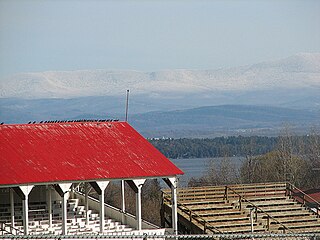
Westport is a town in Essex County, New York, United States overlooking Lake Champlain. The population was 1,312 at the 2010 census.

The Adirondack Park is a part of New York's Forest Preserve in northeastern New York, United States. The park was established in 1892 for “the free use of all the people for their health and pleasure”, and for watershed protection. The park's boundary roughly corresponds with the Adirondack Mountains. Unlike most state parks, about 52 percent of the land is privately owned inholdings. State lands within the park are known as Forest Preserve. Land use on public and private lands in the park are regulated by the Adirondack Park Agency. This area contains 102 towns and villages, as well as numerous farms, businesses, and an active timber-harvesting industry. The year-round population is 132,000, with 200,000 seasonal residents. The inclusion of human communities makes the park one of the great experiments in conservation in the industrialized world. The Forest Preserve was designated a National Historic Landmark in 1963.
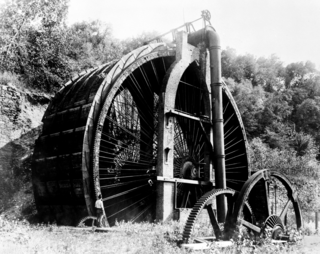
The Burden Iron Works was an iron works and industrial complex on the Hudson River and Wynantskill Creek in Troy, New York. It once housed the Burden Water Wheel, the most powerful vertical water wheel in history. It is widely believed that George Washington Gale Ferris Jr., inventor of the Ferris wheel, had occasion to observe the wheel while a student at Rensselaer Polytechnic Institute. The iron works site was listed on the National Register of Historic Places as an archaeological site in 1977. The Burden Ironworks Office Building was previously listed in 1972.

Sloss Furnaces is a National Historic Landmark in Birmingham, Alabama in the United States. It operated as a pig iron-producing blast furnace from 1882 to 1971. After closing, it became one of the first industrial sites in the U.S. to be preserved and restored for public use. In 1981, the furnaces were designated a National Historic Landmark by the United States Department of the Interior.

Republic Steel is an American steel manufacturer that was once the country's third largest steel producer. It was founded as the Republic Iron and Steel Company in Youngstown, Ohio in 1899. After rising to prominence during the early 20th Century, Republic suffered heavy economic losses and was eventually bought out before re-emerging in the early 2000s as a subsidiary. The company currently manufactures Special Bar Quality (SBQ) steel bars and employs around 2,000 people. It is currently owned by Grupo Simec, based in Guadalajara, Mexico.
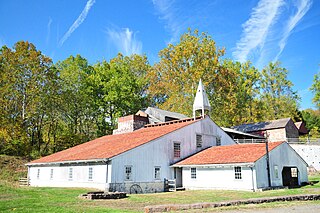
Hopewell Furnace National Historic Site in southeastern Berks County, near Elverson, Pennsylvania, is an example of an American 19th century rural "iron plantation," based a charcoal-fired cold-blast iron blast furnace. The significant restored structures include the furnace group (blast furnace, water wheel, blast machinery, cast house and charcoal house), plus the ironmaster's house, company store, blacksmith's shop, barn and several worker's houses.

Ringwood Manor, located in Passaic County, New Jersey, was the site of an ironworks and home to a number of well-known ironmasters from the 1740s to the late 19th century. The current manor house was not built until 1807.

The Tannehill Ironworks is the central feature of Tannehill Ironworks Historical State Park near the unincorporated town of McCalla in Tuscaloosa County, Alabama. Listed on the National Register of Historic Places as Tannehill Furnace, it was a major supplier of iron for Confederate ordnance. Remains of the old furnaces are located 12 miles (19 km) south of Bessemer off Interstate 59/Interstate 20 near the southern end of the Appalachian Mountains. The 2,063-acre (835 ha) park includes: the John Wesley Hall Grist Mill; the May Plantation Cotton Gin House; and the Iron & Steel Museum of Alabama.

Tahawus was a village in the Town of Newcomb, Essex County, New York, United States. It is now a ghost town situated in the Adirondack Park. Tahawus is located in Essex County within the unpopulated northern area designated to the town of Newcomb. Tahawus was the site of major mining and iron smelting operations in the 19th century. Although standing as recently as 2005, the last mining facilities have since been demolished and removed.

The Phoenix Iron Works, located in Phoenixville, Pennsylvania, was a manufacturer of iron and related products during the 19th century and early 20th century. Phoenix Iron Company was a major producer of cannons for the Union Army during the American Civil War. The company also produced the Phoenix column, an advance in construction material. Company facilities are a core component of the Phoenixville Historic District, a National Register of Historic Places site that was in 2006 recognized as a historic landmark by ASM International.

Oxford Furnace is a historic blast furnace on Washington Avenue, near the intersection with Belvidere Avenue, in Oxford, Oxford Township, Warren County, New Jersey. The furnace was built starting in 1741 and produced its first pig iron in 1743. The first practical use in the United States of hot blast furnace technology took place here in 1834. The furnace was added to the National Register of Historic Places on July 6, 1977 for its significance in industry during the 19th century. It was later added as a contributing property to the Oxford Industrial Historic District on August 27, 1992.

Jay Bridge is a wooden covered bridge that spans the east branch of the Ausable River in Jay, Essex County, New York, USA. It is eligible to be listed in the National Register of Historic Places. Of the 29 covered bridges in New York State, it and the Copeland Bridge in the town of Edinburg, Saratoga County are the only two situated in the Adirondacks.

Principio Furnace and village is in Cecil County, Maryland, 4 miles (6.4 km) northeast of Havre de Grace, MD.
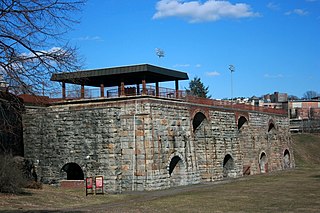
The Scranton Iron Furnaces is a historic site that preserves the heritage of iron making in the U.S. State of Pennsylvania and is located in Scranton, near the Steamtown National Historic Site. It protects the remains of four stone blast furnaces which were built between 1848 and 1857. Iron production on the site was started by Scranton, Grant & Company in 1840. Later, the furnaces were operated by the Lackawanna Iron & Coal Company. In 1847, iron rails for the Erie Railroad were made at the site. In 1865, Scranton, Grant & Company had the largest iron production capacity in the United States. In 1875, steel production started at the site. In 1880, the furnaces produced 125,000 tons of pig iron, one of the main uses of which was in the making of t-rails. The plant was closed in 1902, when production was shifted to Lackawanna, New York.
New York State Route 373 (NY 373) is a short state highway in Essex County, New York, within Adirondack Park. It begins at U.S. Route 9 (US 9) and proceeds eastward, ending at a ferry landing on Lake Champlain. It intersects two county routes, several local roads, and a reference route—NY 912T—which connects it with US 9. NY 373 is the only connector between US 9 and the hamlet of Port Kent and the ferry that serves it.
Blue Ridge Road is a 19.2-mile (30.9 km) long roadway in Essex County, New York, in the United States. The road is designated as County Route 84 (CR 84) from NY 28N in Newcomb to Interstate 87 (I-87) in North Hudson, and as New York State Route 910K (NY 910K) between I-87 and U.S. Route 9 (US 9) in North Hudson. The CR 84 portion is an 18-mile (29 km), two-lane stretch of rural highway maintained by the Essex County Department of Public Works' Highway Division while NY 910K is a 1 mile (1.6 km) highway maintained by the New York State Department of Transportation (NYSDOT). All of Blue Ridge Road has been designated as the "Blue Ridge Road Scenic Byway" by NYSDOT.
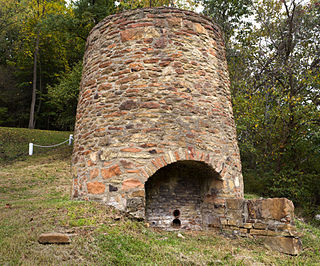
The Peter Tarr Furnace was the first iron furnace west of the Alleghenies. The furnace was built in the 1790s by a man named Grant on property owned by American pioneer James Campbell along Kings Creek near modern Weirton, West Virginia in Hancock County. Peter Tarr purchased the business shortly after its construction, as Grant was no longer able to maintain it. Along with a partner, Peter Tarr then established the firm of Connell, Tarr, & Company. A forerunner to the modern steel mill, the furnace was fueled using local timber and produced about 2 tons of metal daily.
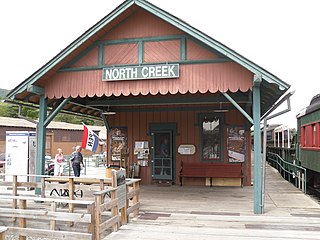
North Creek station is a historic railroad station complex located at North Creek, Warren County, New York. The complex consists of the railroad station, the freight house, round house, turntable, and horse barn. The station was built in 1874 and is a simple, rectangular, gable roofed building with a broad, overhanging strut-supported roof in the Stick-Eastlake style. Its exterior is covered with vertical boards.






















